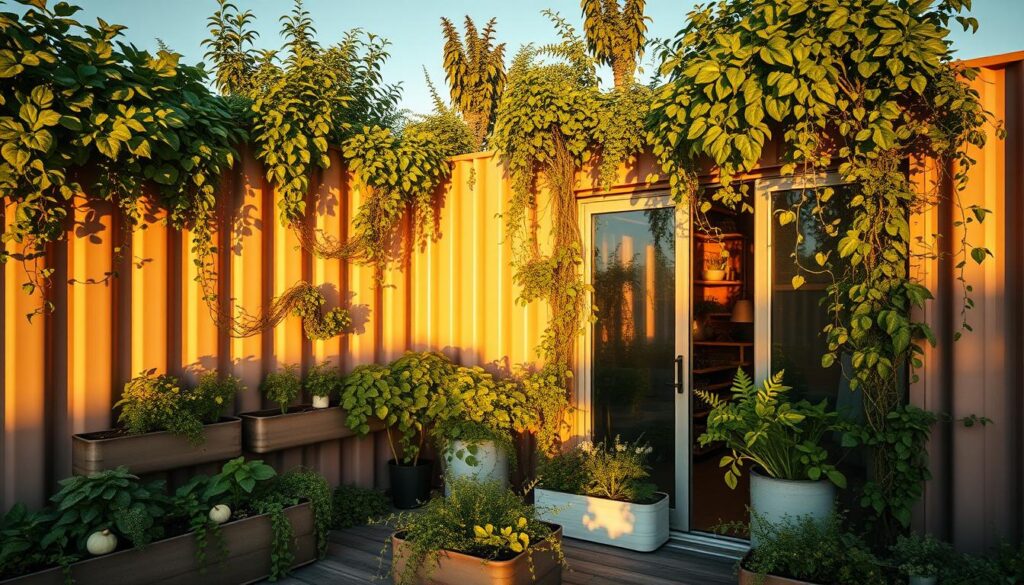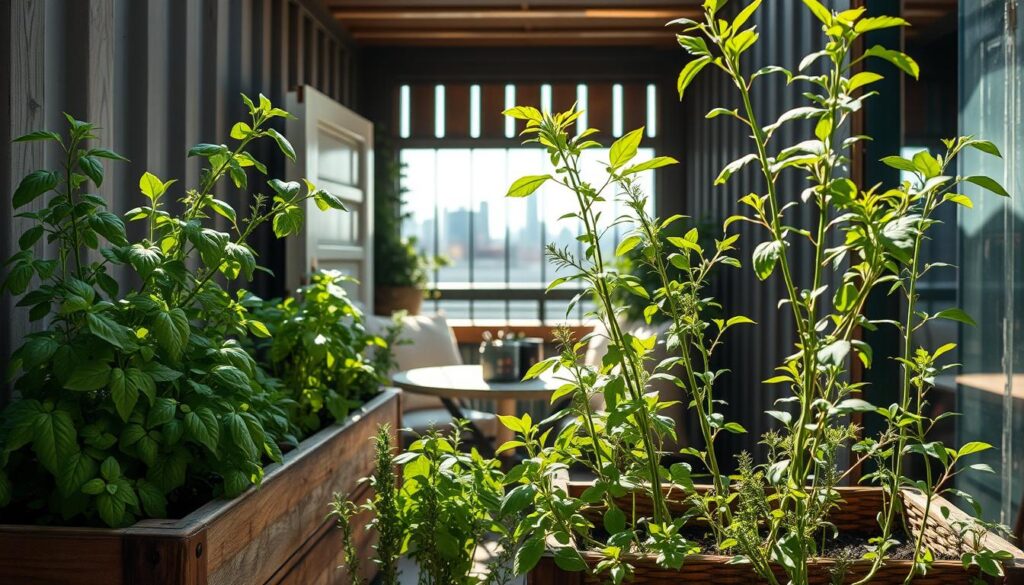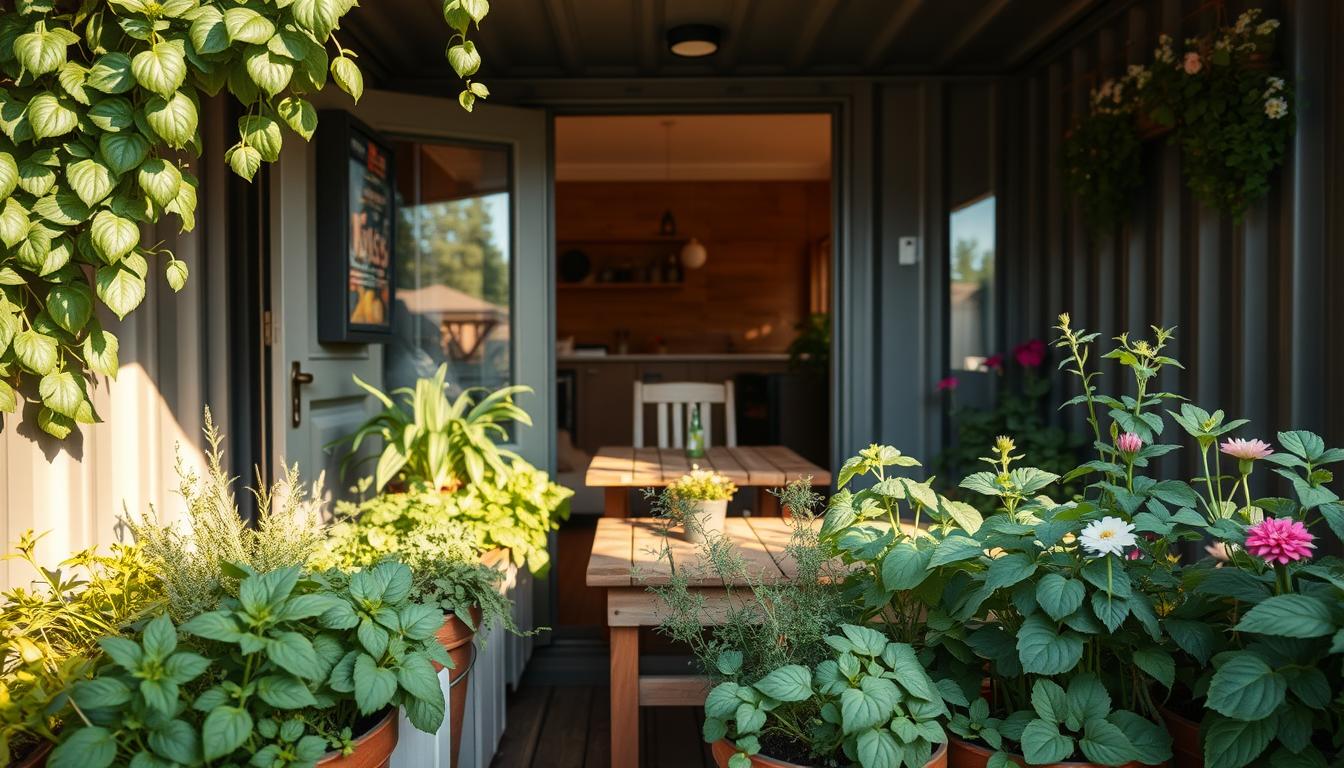Imagine having the ability to cultivate your own food in the comfort of your own home, regardless of the space available. This is now a reality with the innovative use of shipping containers for gardening.
Shipping containers are being repurposed to tackle environmental and societal challenges, including sustainable food production. By converting these containers into controlled growing environments, individuals can monitor and adjust factors like temperature, moisture, and light to create optimal conditions for their crops.
This method, known as container gardening, is particularly appealing to beginners due to its simplicity and flexibility. It allows for the efficient use of space and can be a step towards a more self-sufficient lifestyle.
Key Takeaways
- Container gardening is a simple and efficient way to produce food.
- Shipping containers can be repurposed for controlled growing environments.
- This method allows for optimal control over growing conditions.
- It’s an ideal solution for beginners and those with limited space.
- Container gardening can contribute to a more self-sufficient lifestyle.
The Benefits of Container Gardening for Shipping Container Living
Shipping container homes with container gardens provide a unique blend of sustainability and self-sufficiency, revolutionizing the way we think about food production and consumption. By integrating container gardening into shipping container living, individuals can enjoy a multitude of benefits that enhance their quality of life.
Sustainability and Self-Sufficiency
Container gardening promotes sustainable living by enabling individuals to grow their own food, thereby reducing reliance on industrial agriculture and transportation. This approach to gardening is particularly beneficial in urban settings, where space is limited. As container farms can be placed almost anywhere, they offer a viable solution for urban farming in shipping containers. Moreover, container farms enable all-year farming, provide better security, and save water, using up to 10 times less than traditional farms.
“The beauty of container gardening lies in its ability to bring sustainability to the forefront of urban living,” says a renowned expert in sustainable living. “It’s a step towards self-sufficiency that not only benefits the individual but also contributes to a healthier planet.”
Economic Advantages of Growing Your Own Food
Growing your own food in a container garden can have significant economic advantages. By producing your own fruits, vegetables, and herbs, you can reduce your grocery bills and save money. Additionally, container gardening can increase the value of your property, making it more attractive to potential buyers if you decide to sell in the future.
- Reduced grocery bills
- Increased property value
- Potential for selling excess produce
Mental and Physical Health Benefits
Container gardening also offers numerous mental and physical health benefits. The act of gardening is known to reduce stress and improve mental well-being. Physically, it provides an opportunity for exercise and outdoor activity, contributing to overall health. As individuals engage in container gardening, they not only cultivate plants but also cultivate a healthier lifestyle.
Planning Your Container Garden Space
Effective container gardening begins with assessing and planning the available space around your shipping container home. To maximize space for fresh produce, it’s crucial to consider every possible area that can be utilized for gardening.
Assessing Available Space Around Your Container Home
When assessing the available space, consider both the immediate surroundings and the overall layout of your property. This includes evaluating the condition and potential of different areas for gardening.
Utilizing Side Yards and Perimeter Areas
Side yards and perimeter areas around your container home can be ideal for gardening. These spaces can be used for container gardening ideas such as raised beds or vertical gardens, maximizing the area available for growing fresh produce.
Incorporating Gardens into Your Container Home Design
Incorporating gardens into your container home design from the outset can enhance both the aesthetic and functionality of your living space. Consider integrating planters and garden areas into your home’s architecture to create a seamless transition between indoors and outdoors.
Determining Sun Exposure and Microclimates
Understanding the sun exposure and microclimates around your container home is vital for successful gardening. Observe the sunlight patterns throughout the day to determine which areas receive full sun, partial shade, or full shade, and plan your garden accordingly. For more detailed guidance on starting a shipping container farm, you can visit Boxhub’s resource page.
Creating a Garden Layout Plan
Once you have assessed your space and understood the sun exposure, create a garden layout plan. This plan should consider the mature size of plants, their growing requirements, and the paths needed for maintenance. A well-thought-out plan will help you maximize space for fresh produce and ensure a thriving garden.
Essential Container Gardening Equipment
The right equipment is the backbone of a successful container gardening experience. To grow a thriving container garden, you’ll need to select the right containers, tools, and supplies. This section will guide you through the essential equipment needed to get started.
Container Types and Materials
Choosing the right container is crucial for the health of your plants. Containers come in various materials, including plastic, clay, and wood. Plastic containers are lightweight and easy to clean, while clay containers offer better aeration and moisture regulation. Wooden containers add a natural aesthetic to your garden.
Upcycled and Repurposed Container Ideas
Consider upcycling or repurposing items as containers to add a unique touch to your garden. Old boots, wooden crates, and plastic tubs can be creatively transformed into planters. DIY container garden tips often suggest using items like colanders or wooden barrels to create a distinctive garden feature.
Tools and Supplies Checklist
Having the right tools and supplies is essential for maintaining your container garden. Here’s a basic checklist:
- Gloves
- Trowel or small shovel
- Watering can or hose
- Fertilizers
- Potting mix
- Pruning shears
Budget-Friendly Equipment Options
Starting a container garden doesn’t have to break the bank. Look for budget-friendly options such as thrift stores, garage sales, or online marketplaces for affordable containers and tools. Consider repurposing household items to save money.
| Equipment | Average Cost | Budget-Friendly Alternative |
|---|---|---|
| Plastic Containers | $5-$10 | Repurposed plastic tubs |
| Gardening Gloves | $10-$20 | Old work gloves |
| Trowel or Small Shovel | $5-$15 | Old kitchen utensils |
Soil, Irrigation, and Drainage Systems
The success of a container garden hinges on three critical elements: the right soil mix, efficient irrigation, and proper drainage. When growing veggies in a shipping container garden, it’s essential to understand how these components work together to create a thriving environment.
Selecting the Right Soil Mix for Containers
Choosing the appropriate soil mix is the first step towards a healthy container garden. The ideal mix should retain moisture but also drain excess water efficiently. A good container soil mix typically includes a blend of peat moss, vermiculite, and perlite. This combination supports root health and prevents waterlogged soil.
Setting Up Efficient Watering Systems
Efficient irrigation is crucial for container gardens. Overwatering can be as detrimental as underwatering. There are several methods to ensure your plants receive the right amount of water.
Rainwater Harvesting from Your Container Roof
One eco-friendly solution is to harvest rainwater from your container roof. This not only conserves water but also reduces your water bill. By installing a rainwater harvesting system, you can collect and store rainwater for use during dry periods.
Automated Irrigation Options
For a more technologically advanced approach, consider automated irrigation systems. These systems can be programmed to water your plants at optimal times, reducing waste and ensuring consistency.
Ensuring Proper Drainage
Proper drainage is vital to prevent root rot and other issues associated with waterlogged soil. Ensure your containers have adequate drainage holes. You can also use a layer of small rocks or broken pottery at the bottom of the container to improve drainage.
| Component | Function | Benefits |
|---|---|---|
| Peat Moss | Retains Moisture | Reduces watering frequency |
| Vermiculite | Improves Soil Structure | Enhances root growth |
| Perlite | Enhances Drainage | Prevents waterlogging |
By focusing on these critical aspects, you can create a thriving container garden that provides fresh produce throughout the growing season.
Grow Fresh Food Outside Your Shipping Container Home: Best Plant Selections
Selecting the best plants for your container garden is crucial for a bountiful harvest outside your shipping container home. Container gardening offers a wide range of possibilities for growing fresh produce, from leafy greens and herbs to fruit-bearing plants.
Vegetables That Thrive in Container Gardens
Container gardens can support a variety of vegetables, depending on the container size and growing conditions. Vegetables that do well in containers typically require minimal space or can thrive in shallow soil.
Leafy Greens and Shallow-Root Vegetables
Leafy greens such as lettuce, kale, and spinach are ideal for container gardens because they have shallow roots and can be harvested in as little as 20 days. Other shallow-root vegetables like radishes and green onions also do well.
Root Vegetables and Tubers
For root vegetables and tubers, containers need to be deeper to accommodate their root systems. Carrots and beets can be grown in deeper containers, while potatoes require even more depth. These plants are rewarding to grow in containers and can be quite productive.
Herb Gardens for Small Spaces
Herbs are a great choice for container gardens, especially in small spaces around shipping container homes. Many herbs, such as basil, mint, and cilantro, are easy to grow and require minimal care. They can be used to add fresh flavors to a variety of dishes.
Fruit-Bearing Plants for Container Growing
Fruit-bearing plants like strawberries, blueberries, and dwarf citrus trees can thrive in containers. These plants not only provide fresh fruit but can also add aesthetic value to your outdoor space.
When choosing fruit-bearing plants, consider the container size and the plant’s sunlight requirements. Many fruit-bearing plants require full sun to produce well, so selecting a location that receives adequate sunlight is crucial.
Vertical and Space-Saving Gardening Techniques
For those living in shipping container homes, utilizing vertical space is key to a thriving garden. With the right techniques, you can maximize your space and enjoy a bountiful harvest.
Vertical Growing Systems and Trellises
Vertical growing systems and trellises are excellent ways to make the most of your container home’s space. These systems allow plants to grow upwards, increasing yield without taking up more ground space. Some popular options include:
- Hydroponic systems
- Living walls
- Trellises for climbing plants like peas and beans
Trellises are particularly useful for plants that naturally climb or spread out, providing support and keeping them organized.
Hanging Gardens and Wall-Mounted Planters
Hanging gardens and wall-mounted planters offer another effective way to utilize vertical space. These can be used for a variety of plants, from herbs and succulents to flowering plants and vegetables. When choosing hanging gardens or wall-mounted planters, consider the weight capacity and ensure they are securely attached to withstand weather conditions.
Wall-mounted planters are especially useful for adding greenery to areas with limited floor space, making them perfect for container homes.
Maximizing Roof Space for Growing
Roof space in container homes can be a valuable asset for gardening. By creating a rooftop garden, you can grow a wide range of plants, from vegetables and herbs to fruits and flowers. However, it’s crucial to consider the structural integrity of your roof before starting.
Structural Considerations for Rooftop Gardens
Before turning your roof into a garden, ensure that it can support the weight of the soil, plants, and any additional features like irrigation systems. Consulting with a structural engineer can help determine the roof’s capacity and necessary reinforcements.
Some key considerations include:
- Weight capacity of the roof
- Drainage and waterproofing
- Accessibility for maintenance

By implementing these vertical and space-saving gardening techniques, you can enjoy a lush, productive garden even in the most space-constrained container home.
Seasonal Gardening Calendar for Container Homes
To keep your container garden flourishing throughout the year, it’s crucial to follow a seasonal gardening plan tailored to your container home. This involves adjusting your planting, maintenance, and protection strategies according to the season, ensuring your garden remains healthy and productive.
Spring Planting Guide
Spring is a great time to start planting a variety of vegetables, herbs, and flowers in your container garden. Begin by selecting cold-hardy plants that can withstand the cooler temperatures. As the weather warms, you can transition to warmer-season crops. Make sure to use a well-draining potting mix and containers with adequate drainage holes.
Container gardening ideas for spring include using vertical space with trellises or wall-mounted planters to maximize your growing area.
Summer Maintenance Tips
During the summer, your container garden will require more frequent watering due to the warmer temperatures. Check the soil moisture daily, and water thoroughly when the top inch of soil feels dry. Regular fertilization is also crucial to promote healthy growth and fruiting.
Keep an eye out for pests and diseases, and take action promptly if you notice any issues. Summer is also a good time to prune and train your plants to maintain their shape and encourage productivity.
Fall Harvesting Strategies
As fall approaches, start preparing your container garden for the cooler weather by transitioning to cool-season crops. Many vegetables and herbs thrive in the cooler temperatures of fall, providing a bountiful harvest. Continue to maintain good soil health and keep an eye out for any signs of pests or disease.
Winter Container Gardening and Protection
In the winter, protect your containers from freezing temperatures by moving them to a sheltered location or using insulating materials around the containers. Consider using cold frames or hoop houses to extend the growing season. For containers that cannot be moved, use protective covers to shield them from harsh winds and frost.
By following this seasonal gardening calendar, you can enjoy a thriving and productive container garden throughout the year, incorporating valuable container gardening ideas into your routine.
Harvesting and Using Your Container Garden Bounty
The moment of truth arrives when it’s time to harvest the fruits of your labor from your container garden. Growing herbs on your shipping container patio is not just about the process; it’s about enjoying the fruits of your labor. Whether you’ve cultivated a variety of vegetables, herbs, or fruits, the joy of harvesting is a significant part of the container gardening experience.
Harvesting Techniques for Maximum Yield
To maximize your yield, it’s essential to harvest your crops at the right time. For leafy greens like lettuce and kale, this means picking the outer leaves to encourage continuous growth. For tomatoes and peppers, harvesting when they’re fully colored ensures the best flavor. Regular harvesting also encourages plants to produce more.
- Check your plants regularly for ripe produce.
- Use clean, sharp tools to avoid damaging the plants.
- Harvest in the morning for better flavor and texture.
Preserving Your Harvest
Preserving your harvest allows you to enjoy your container garden’s bounty throughout the year. Techniques like freezing, canning, and dehydrating are effective ways to preserve vegetables, herbs, and fruits. For herbs, making herb butters or freezing them in ice cube trays with olive oil are simple preservation methods.
- Blanch vegetables before freezing to preserve color and nutrients.
- Use airtight containers for canning to prevent spoilage.
- Store dried herbs in a cool, dark place to retain flavor.
Simple Recipes Using Container Garden Produce
Using fresh produce from your container garden in simple recipes enhances meals with fresh flavors. A fresh salad with mixed greens, cherry tomatoes, and herbs like basil or cilantro is a quick and delicious option. You can also make a flavorful pesto with basil, garlic, and olive oil to enjoy with pasta or as a dip.

Experimenting with different recipes and preservation techniques not only adds variety to your meals but also makes the most of your container gardening efforts. Enjoy the process of harvesting and using your container garden bounty to create delicious, healthy meals.
Conclusion: Creating a Sustainable Lifestyle with Your Container Garden
Embracing container gardening in your shipping container home is a significant step towards achieving sustainable living with container gardens. By growing your own food, you not only have access to fresh produce but also contribute to reducing the reliance on commercial agriculture.
This sustainable practice promotes self-sufficiency and enhances overall well-being. Container gardens can thrive in small spaces, making them ideal for shipping container homes. By adopting this lifestyle, individuals can enjoy a more environmentally friendly and healthy way of living.
As you continue to nurture your container garden, you will realize the numerous benefits it provides, from economic advantages to mental and physical health benefits. By incorporating container gardening into your daily life, you can create a more sustainable and fulfilling lifestyle.

